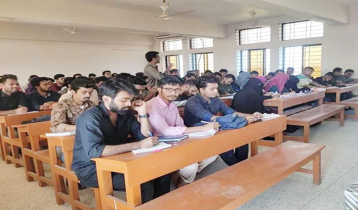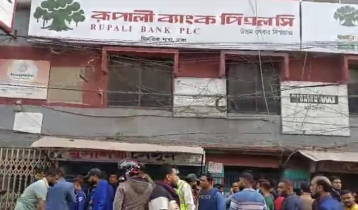Unmasking the hidden hunger in Bangladesh!
Billal Hossen || risingbd.com

Billal Hossen
Hunger simply indicates the distress related to lack of food. You can feel it in your belly only. But, when it comes to hidden hunger it doesn’t produce hunger in your belly and even you couldn’t feel it. That’s why it is called a hidden hunger.
According to the World Health Organization (WHO) “Hidden hunger is a form of undernutrition that occurs when intake or absorption of vitamins and minerals is too low to sustain good health and development in children and normal physical and mental function in adults”.
Simply, hidden hunger is the deficiency of vitamin and minerals. For this reason, hidden hunger is also known as ‘micronutrient deficiency’ as the vitamin and minerals both are micronutrients. Most importantly, the diet of Bangladeshi people is deprived of vitamin-A, vitamin-D, Iron, Iodine, Zinc and calcium.
Micronutrient deficiency or hidden hunger still remains a far cry in Bangladesh. COVID-19 pandemic worsen the situation by disrupting the entire food chain. Due to this pandemic, the marginal people especially poor children, adolescent girl, and geriatric people, pregnant and lactating mother hit hardest.
This tough situation puts them in a humanitarian crisis. They lack enough food to sustain their life. Although, some of them having accessibility towards staple food such as rice but there is no dietary diversity in their diet.
As a result, most of the people of our country lacking vitamin and minerals in their diet which is most important in developing a strong immune system to fight different diseases including coronavirus.
According to World Fish “In Bangladesh, there are more 20 million people suffering from chronic deficiencies of vitamin-A, Iron and Zinc”. They also indicate that particularly women and children’s are the most vulnerable. National Micronutrient Survey of Bangladesh revealed that the prevalence of vitamin-A, Iron, Iodine, Zinc, vitamin-D, and Calcium among pre-school age children (6-59 months) are 20.5%, 10.7%, 40%, 44.6%, 39.6% and 24.4% respectively. The prevalence of vitamin-A deficiency among school-age children (6-14 years) are 20.9%. Further, they also reported that the prevalence of Iodine, Zinc, vitamin-D and Calcium among non-pregnant and non-lactating are 42.1%, 57.3%, 71.5% and 26.3% respectively.
By examining this report, it is clear that women and children are more vulnerable to hidden hunger. Though the sign of hidden hunger is not visible but it can lead to irrevocable damage to the children and adversely affect the entire communities and the economies of the entire nation. It is just like a slow poison or silent killer.
Recently, the Global Hunger Index (GHI)-2020 was published by IFPRI where Bangladesh ranks 75th out of the 107 countries. With a score of 20.4, Bangladesh has a level of hunger that is ‘serious’. This means we are not in satisfactory condition. To calculate GHI, they consider three dimensions namely childhood mortality, inadequate food supply and child undernutrition.
The abovementioned dimensions do not necessarily reflect the real scenario of micronutrient deficiencies among Bangladeshi people. For this reason, we are neglecting the ‘hidden hunger’. It is high time to unmask the real scenario and pave the way to address it. We just need to overlook the GHI score for our better future.
There are several causes of hidden hunger in a country like Bangladesh. As it is a disaster-prone country, any disaster can affect the entire food chain and obstruct the flow of food while reaching to the consumer thus the consumer deprived of a variety of food and suffering from micronutrient deficiencies.
Poor diet is another cause of hidden hunger. Most of the people of our country live in a marginal family and eat staple crops like rice, wheat, maize and cassava which provides a large share of energy but relatively low in vitamin and minerals.
Some people have the ignorance to balanced diet or nutritious food, they eat mostly plant-based food thus they are deprived of vitamin and minerals. Some people are unable to afford or access a wide range of nutritious food such as animal based food (meat, eggs, fish or dairy) due to the shortage of money. Price hike also halts the consumption of micronutrients among consumers.
Micronutrient deficiencies cause several health problems in different ages such as in children, it can cause stunting, reduced mental capacity, frequent infections, inhibit cognitive development, reduce learning capacity and trigger higher mortality. On other hand, in the case of pregnant women, it can increase mortality and perinatal complications.
Now, what is the solution to this problem? Yes, there are some sustainable ways to resolve this problem.
Dietary diversity
Dietary diversity simply means the variation in our daily diet menu. Most importantly, adding animal-based foods, fruits, vegetables and other food with cereals. This is the most effective way to sustainably prevent hidden hunger. Home gardening and educating IYCF practices is the best ways to promote dietary diversity.
Food fortification
Fortification of food with micronutrients such as iodine, iron, vitamin-B or zinc is another way to resolve the hidden hunger crisis
Biofortification
Introduce transgenic food (food that is genetically modified with the desired nutrient) to consumers. This method can easily deliver nutrients to the marginal people.
Micronutrient supplementation
To beat hidden hunger we can provide iron, zinc, and calcium or vitamin-D supplementation to the most vulnerable group.
Overall, it is really important to unmask the hidden hunger situation of our country and take the necessary initiatives to address this crisis. Resolving this problem will lead to a healthy nation.
Billal Hossen is currently studying Applied Nutrition and Food Technology at the Islamic University.
Dhaka/Mahfuz






































